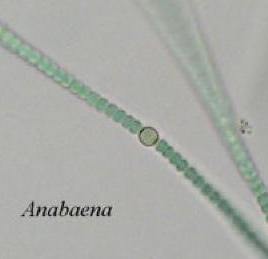
Adaptations
Anabaena is known around the world for its formation
of specialized cells. The largest of these is the
heterocyst cells that form along its
 long chains. These
cells are large vegetative cells that have lost the ability to
photosynthesize in exchange for a thin cell wall and the ability
to
fix nitrogen in the absence, or low amounts, of oxygen. Heterocysts can form either inside the chain, known and
intercalary heterocysts, or on the ends, known as terminal heterocysts. However in Anabaena they are only found intercalary
in the trichome.
long chains. These
cells are large vegetative cells that have lost the ability to
photosynthesize in exchange for a thin cell wall and the ability
to
fix nitrogen in the absence, or low amounts, of oxygen. Heterocysts can form either inside the chain, known and
intercalary heterocysts, or on the ends, known as terminal heterocysts. However in Anabaena they are only found intercalary
in the trichome.
Another type of specialized cell that Anabaena have are
akinetes. These are another vegetative cell that enlarges and fills
with food reserves. These cells have been found to form about
midway between two heterocysts and proceeds towards the heterocysts.
At maturity these cells are found next to the heterocysts, and provide
all the necessary food for them. Since the heterocysts cannot
photosynthesize, it is very important for these cells to be near.
Also, the enzyme nitrogenase, which is what allows the heterocyst to
perform nitrogen fixation, is unstable in the presence of oxygen, so akinetes help to keep these two essential components separated.
proceeds towards the heterocysts.
At maturity these cells are found next to the heterocysts, and provide
all the necessary food for them. Since the heterocysts cannot
photosynthesize, it is very important for these cells to be near.
Also, the enzyme nitrogenase, which is what allows the heterocyst to
perform nitrogen fixation, is unstable in the presence of oxygen, so akinetes help to keep these two essential components separated.
To learn how Anabaena acquires other nutrients head over to the nutrition page.

If you have already seen the nutrition page lets see how they use these nutrients to grow and develop, or head back to the main page!